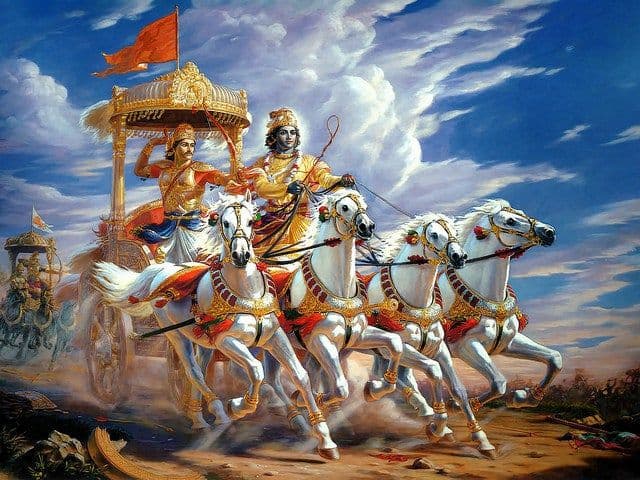
Mahabharata: Ancient Story or Real History? Let’s Investigate
A personal journey into the epic’s real-life roots, lost cities, and facts that might change your mind.

The 1988 Mahabharata TV series that brought legends to life.
When I was a kid, we didn't have a proper TV connection, so my evenings were mostly about my grandma telling stories—especially Mahabharata and Ramayana.
Honestly, back then, without any visuals, these stories felt kind of boring and distant. That changed completely around 2010, when I watched reruns of B.R. Chopra's iconic Mahabharata series from the late '80s.
Suddenly, the epic wasn't just a story—it felt vividly real. Characters like Krishna, Arjuna, and Bhishma started living in my mind like actual historical figures.
But could such incredible stories actually be true?

Archaeologists discovered ruins off Gujarat’s coast—was this the legendary city of Dwarka?
Well, it turns out there's genuine evidence hidden beneath the waves off Gujarat—ruins of a submerged city believed to be Krishna’s legendary Dwarka. Carbon dating places these ruins exactly around the timeline described in the Mahabharata. Honestly, the idea of a lost underwater city fascinated me instantly.
Then there's Kurukshetra in Haryana—my home state—where the epic war took place. Archaeologists actually found ancient weapons, chariot wheels, and other artifacts there, perfectly matching descriptions from Mahabharata. Every discovery pulled me deeper into believing these stories weren't just myths.
The School Disconnect vs. Family Faith
Yet at school, Mahabharata was barely mentioned.
It always felt strange—why did stories of British rule or Mughal invasions take precedence, while our own history remained sidelined?
Meanwhile, my grandparents never had any doubt. Their bookshelf was packed with Mahabharata and Ramayana scriptures in Sanskrit, all meticulously maintained, clearly indicating their unwavering belief in these stories.
The Bhagavad Gita, Steve Jobs, and a Modern Spark
My real interest started when I discovered the Bhagavad Gita thanks to A.C. Bhaktivedanta Swami Prabhupada, the Hare Krishna movement's founder. He simplified the complex teachings of Krishna, sparking my curiosity.
Later, Steve Jobs' biography mentioned his India visit, specifically highlighting his spiritual quest linked to Krishna and Hare Krishna temple visits.
If Jobs, a tech visionary, found something meaningful here, surely there was something deeper.
Science and Suspense: The Mahabharata’s Astronomical Puzzle
Then I stumbled upon Nilesh Oak’s research, which took my curiosity to another level. Oak matched precise astronomical references from Mahabharata—like stars and planetary alignments—to modern astronomy software.
One mind-blowing fact was about the stars Arundhati and Vashisht. Normally, Vashisht leads Arundhati in the sky, something that hasn't changed for thousands of years.
But surprisingly, there was one short window around 5561 BCE when Arundhati briefly moved ahead of Vashisht—exactly matching Mahabharata descriptions.

Astronomers confirm: Arundhati & Vashisht’s unique alignment matches the Mahabharata era.
Even more astonishing was oceanographic evidence.
It confirmed massive flooding around Dwarka around 5525 BCE, precisely matching the Mahabharata’s account of the city’s destruction.
Genetic studies added another twist, showing distinct lineages in certain Indian populations, supposedly descendants from Pandavas, Kauravas, and Yadavas.
Another intriguing piece is the Saraswati River—described extensively in Mahabharata as wide and flowing. Satellite imagery confirmed this now-dry river once existed exactly as ancient texts described.
Do We Still Need Outside Proof?
But even with all this evidence, many still hesitate.
Sadly, as Indians, we often wait for Western validation to fully believe our own history.
From a skeptical child listening half-heartedly to my grandma, to someone deeply immersed in exploring ancient texts and scientific findings, my journey has convinced me:
Mahabharata isn’t just mythology—it's authentic history.
Every fact, every discovery only strengthens this belief.
📖 Did you know?
Mahabharata contains over 1.8 million words—making it more than 10 times longer than Homer’s Iliad and Odyssey combined.
This level of detail is rare in any ancient literature!
If you're curious, I invite you to pick up the Bhagavad Gita, read it as Arjuna did—with an open mind—and you might just find answers and insights incredibly relevant, even today.

Ancient Fiction or Real History?
So, what do you think? Ancient fiction or genuine history?
Dive in, explore, and maybe you’ll uncover your own answers within the fascinating world of Mahabharata.
Have you ever thought about whether Mahabharata is historically real?
Let’s talk about it!